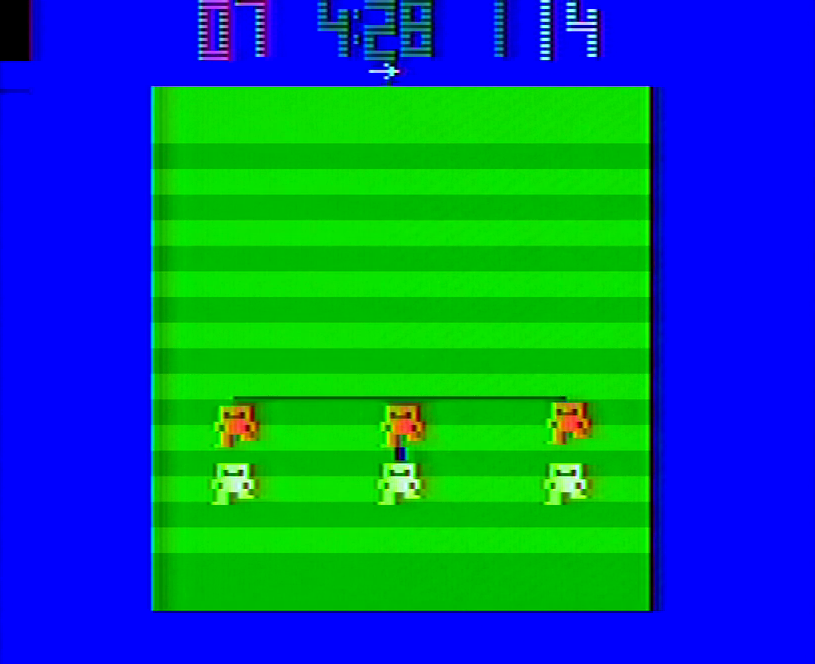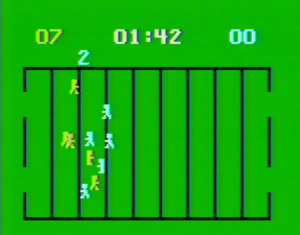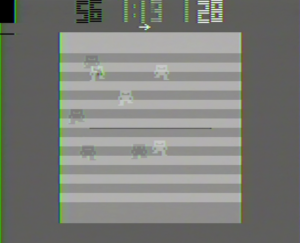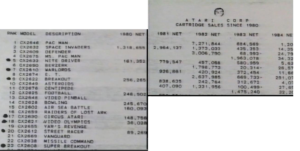
Here we go again with another sports game for the Atari VCS that is a bit of an odd fit for the console. Unlike two other prominent and effective sports translations to the platform – fellow March release Bowling and 1978’s Basketball – Football is a game that, by its nature, requires teams to field far more players than the limited number of sprites the VCS can normally place on screen. Despite this, the game actually kind of works, and is a fun, if not terribly accurate, take on the sport.
Football was written by Bob Whitehead, the same fellow behind the 1978 release Home Run – another team sports game that tried to translate something the VCS is ill-suited for. In fact, Whitehead said that Football runs a similar kernel as Home Run – a kernel being a graphics-generating part of the program, essentially the VCS equivalent of a game’s engine. In that game, he was able to multiplex sprites to create a line of three fielders at a given time, and using sprite flickering – alternating which sprite appears where on each individual frame – he could create the appearance of many more players on the field at once. This technique doesn’t come across great on modern displays, but on an old cathode-ray tube television, it’s a bit more subtle. Like baseball, football requires a lot of players, so Whitehead once again combined multiplexed sprites with flicker to field two teams of four players each, alternating which player is visible each frame.
In many ways, Whitehead was carving out his own path on what a football game could look like on a game system.There were early, text-based renditions of the sport – notably one developed in 1965 by John Kemeny at Darthmouth on that university’s Time Sharing System in BASIC, known as FTBALL. Kemeny considered games as an excellent way to break down the fear of the machines, and this game – initially single player, with multiplayer added later – pit Dartmouth against Princeton. The game kept track of downs, yardage and whose turn it was on offense and defense, with players always controlling Dartmouth and inputting plays. The results of each scrimmage and play were based on statistics input by Kemeny, and after at least 50 plays, the game would end – though there were some random events, such as a dog running onto the field and interrupting the game (a common occurrence at Dartmouth at the time). FTBALL outlasted the DTSS system at Dartmouth, with a variation appearing in David Ahl’s second edition BASIC Computer Games. Intriguingly, another Dartmouth professor, Arthur Luehrmann, wrote a variation of FTBALL that utilized the college’s new Tektronix monitors to display a visual representation of what was going on each turn. It’s unclear if this particular version has survived, but it was a further indication of how using computer technology for entertainment was encouraged at Dartmouth.

On the console side of things, the Magnavox Odyssey shipped with a football game all the way back in 1972. Due to the extreme hardware limitations of the machine, however, this game relied on dice rolls, game cards, a board, and two separate carts to actually be played (one for offense, another for defense), making it more of a hybrid game experience in the vein of the Master Strategy series of games released many years later on its successor, the Odyssey2. The Odyssey2 actually launched in the fall of 1978 with a football game, and not long thereafter Bally published its own Football for its Professional Arcade system around January 1979, but Whitehead provided no indication that these influenced his game – or indeed that they were commercially available while he was working on it. Atari first start advertising the game as coming soon in catalogs around summer 1978 before dropping it until the following year. Whitehead simply noted that Atari was entirely willing to sit on finished games and release them when the company felt like the timing was better, which was likely the case here.
One game Whitehead did have access to was the arcade Atari Football game, released in October 1978 and the company’s biggest hit of the year. According to Keith Smith’s unpublished book All in Color for a Quarter, this game was originally proposed in 1973 but was abandoned as the hardware technology wasn’t ready to control all the necessary objects yet. By 1978 the tech had matured, however, and utilizing similar hardware to Atari’s Tank 8, authors Lyle Rains, Dave Stubben, Jerry Lichac and Mike Albaugh put together a game so well-liked that it sold 11,000 units and was second in popularity only to Midway’s Space Invaders release into 1980. Aside from being among the first games to use a track ball as its controller, this football game was quite successful for the company and a solid attempt at bringing the sport to a video game format. Access doesn’t necessarily denote he was able to draw much from the game, however; Whitehead said that the differences between an arcade machine and the VCS were simply too great to copy what the arcade game was doing, so he had to figure out what worked best with the limited hardware available. As such, while the VCS football game does a surprisingly remarkable job at translating the sport to the machine and providing an arcade experience in its own right, it isn’t exactly capturing the same degree of sophistication as competing football games managed.

Football is primarily designed for two human players. At the start of each play, the offense and defense picks what formation strategy they want by pushing the joystick in one of four cardinal directions or by pushing the button. This is where having the manual – or at least a scan of the different plays – is crucial, as otherwise you are kind of just wildly pushing directions and hoping for the best. Once both players have selected their plays, the game begins. The player on defense controls their linemen, or by holding down the red button, their defensive back. The player on offense controls the ball carrier, and can throw the ball in a pass play by pushing the button, or can punt the ball during a punt play by pushing the button. Not only can the offensive player decide which direction the ball goes in, they can also control its movement left and right after its been thrown or kicked, allowing some degree of control in getting it successfully caught. Once a ball carrier is tackled, the ball is dropped, or a score is made, the players select new plays; if offense hasn’t successfully made it past the down marker within four attempts, they lose control of the ball. This Football also allows for safeties – tackling the ball carrier behind their own goal line – and interceptions, so it does follow the basic rules of the game pretty well.
The difficulty switches in this game adjust how quickly a player can move left and right, which can be a significant advantage. And there are three game types, of course. In the first game type, the players not under direct control will mostly follow the play with some random movements. In the second game type, the players will follow the play selected to the letter, requiring a bit more foresight on the actual human players’ part as they choose what play to run. The third game type is functionally automated – the only input the human players have is on selecting plays and if offense wants to try to pass or kick the ball. Beyond that, the game runs itself.

As I said before, this take on Football is very arcade-y, and the five-minute game sessions tend to fly by with how quickly players can jump into a game. The player sprites a bit weird looking, and the vertical orientation is unusual for the time, though reasonable given the VCS’s limitations. Like Home Run, Whitehead himself was not a fan of the flickering sprites, and as such worked hard to never need to use that technique again after leaving Atari in 1979.
Football as a game genre developed rapidly around this time. Looking at the football games for the Odyssey2 and the Professional Arcade that preceded Atari’s game to market, as well as the Channel F’s Pro Football game that finally released in 1980, the developers were all approaching the game in similar ways to Whitehead. In both the Odyssey2 and Channel F games, you select your plays in the same manner as the VCS Football game – simply pushing the controller in specific ways prior to the play. Players on offense can pass or kick the ball in specific directions, and the Odyssey2 uses its built-in character set to avoid flickering issues entirely. The Channel F game, written by Rick Maurer of Atari Space Invaders fame while he was still at Fairchild, even has an ear-splitting rendition of the Notre Dame fight song to kick the game off! But both of these games are pretty comparable to Whitehead’s take, and owners of a given platform likely had little to envy their neighbors for a given football fix.

Football for the Bally Arcade takes things up to another level of detail, however, utilizing a 4 kilobyte cartridge at a time when most other carts for the system were 2k. Not only does this version of the sport put more players on the field at once, it features full text menus for you to select your plays – by surreptitiously pushing the joystick on the controller when the cursor is on the play you want – with crowd noises and even a four player mode. It also retains the down markers from Whitehead’s game, and uses the spinning knob on the Bally joystick to allow the player to fine tune the angle the ball gets thrown at. Author Bob Ogdon had a passion for the sport, having played football at the University of Puget Sound through a scholarship, and that love shows through here. He was particularly pleased with the implementation of the spinner for passes, remarking in an interview with me that it was truly unique for the time and made for great game play. Given the timing of its release, it’s unlikely to have been influenced by any other football video games, and Ogdon did not recall seeing any before his own take on the sport was written. Ogdon today considers it the best game he ever made, and it’s certainly a standout on the console and for the genre. This might well be the ideal classic football game, if you’re looking for a more fast-paced, arcade style experience that still retains a great deal of strategy. It also exists as something of a half-step between what Atari, Magnavox, and Fairchild’s programmers had done to the next football game to highlight: Mattel’s NFL Football.

As the Mattel Intellivision gradually rolled out nationally in 1980, its marketing started focusing less on its ill-fated computer expansion and more on how realistic its sports games were compared to the market leader, Atari. NFL Football – one of the first licensed sports game ever released – certainly lives up to that comparison, for good and bad. Developed around the end of summer 1978, it is credited to summer hires from CalTech at APh Consulting, Ken Smith and Kevin Miller. According to Smith’s appearance on the Intellivisionaries podcast, Mattel wanted this for a proposed test launch over his next school year, but the originally developed version of the game was extremely buggy and prone to crashing. Smith was asked to debug it, but after looking at what he described as spaghetti code, Smith declared it effectively impossible and suggested they start over. While the game was designed and all the play materials written up by staff at Mattel, it would need a full rewrite for the game itself to run well. With that in mind, he and fellow summer hire Miller did just that, writing a new version of NFL Football from scratch using the same design materials that the original prototype had been based on. While Miller focused on the football field and ensuring smooth scrolling, Smith implemented the rest of the game play according to the existing design. This process took about three weeks, Smith recalled, It is a legitimately fun take on the game, with the famous running man sprite being put to good work here.
The keypad on the controller allows for a pretty sizable mix of plays to be selected from, with an incredible degree of detail – you can even choose which player you specifically will be passing to. The game relies so heavily on the keypad, however, that without the manual or the keypad overlay it is nearly unplayable and you’ll just get a series of buzzing sounds indicating you did something wrong. That said, if you have these materials and some time to learn its intricacies, it is essentially the gold standard for the genre. Game players at the time seemed to agree, with Bill Kunkel and Arnie Katz heaping praise upon it in their Video Magazine overview of the Intellivision. Internal Mattel documentation suggests it shipped out 128,300 units to stores in its initial year of 1980, and a full 980,200 units by the end of June 1983, when the memo ceases tracking. NFL Football would prove influential: when Atari revisited the sport twice on the VCS, both instances clearly leaned more into the simulation aspects like the Intellivision game rather than the more arcade-y elements of Whitehead’s Football. Meanwhile, Mattel would port its NFL Football to the VCS as the frankly delightful Super Challenge Football as part of its M Network lineup in 1982, pulling back the complex play-calling system seen in its predecessor and even VCS Football into something friendlier to the joystick controller. Football games more in line with Mattel’s would also appear on the ColecoVision, Atari 5200 and 7800 game consoles in the years to come.

All this leaves the original Football cartridge for the VCS as both a reasonably fun take on the sport and as an interesting piece of history. Coming out in that window of time before Mattel redefined what a home football game could be and before the more advanced VCS tricks were worked out, the game is at once dated but so approachable that it remains incredibly fun, even to someone like me who doesn’t know the first thing about the actual sport. The game was compared favorably to Bally’s version in a column by Dick Cowan in the April 14, 1979 Xenia Gazette, and while other contemporary takes on Football seem hard to come by, the game remained a steady seller for Atari, showing up in an internal sales document as the 12th best-selling game for the VCS. This document is cutoff in the image we have, but we do know it sold 248,502 units in 1980 and an additional roughly 150,000 between 1986 and 1989, when the game was being stocked alongside its newer brethren Realsports Football and Super Football. Whitehead got it right, whether or not he intended on it – while there’s an audience for advanced football games, there are also an ample number of people who just want to hop in and play against their friends. While the March 1979 VCS releases have a couple duds in the lineup, this isn’t one of them.
Sources:
Bob Whitehead, interview with the author, Sept. 4, 2018
Arthur Luehrmann, interview with the author, Sept. 12, 2022
Bob Ogdon, interview with the author, Aug. 17, 2020
BASIC FTBALL And Computer Programming for All, Annette Vee, digitalhumanities.org
Mike Albaugh, interview with Scott Stilphen, ataricompendium.com, 2017
Xenia Gazette, April 14 1979
Let’s Play: Football (Magnavox Odyssey1972), OdysseyNow
Intellivisionaries, Episode 8
Arcade Alley, Video, August 1980
Football, Blueskyrangers.com
Cartridge Shipment Memo, Mattel Electronics dated Nov. 30, 1983
Atari Corp. 2600 Sales figures, 1986-1990
Once Upon Atari, Howard Scott Warshaw, 2003
Inside Gaming: Meet Bob Ogdon, The Man Behind the Wizard, Electronic Games, May 1982
All in Color for a Quarter, Keith Smith, unpublished manuscript, 2016
Release date sources:
Football! (Odyssey2) – Source: Weekly Television Digest, May 22 1978; Creative Computing, September/October 1978; Northwest Arkansas Times, November 22 1978; Colorado Springs Gazette, November 28 1978
Football (Bally) – Source: Arcadian, January 13 1979; Arcadian, November 6 1978
Football (VCS) – Source: New York Daily News, March 22 1979; Philadelphia Inquirer, April 8 1979; Xenia Gazette, April 14 1979
NFL Football (Intellivision) – Source: Allentown Morning Call, February 17 1980; Modesto Bee, December 10 1979; Santa Ana Orange Counter Register, March 27 1980;Blue Sky Rangers game list
Pro Football (Channel F) (Videocart 24; August 26) – Source: Zircon press release announcing four new games now available
